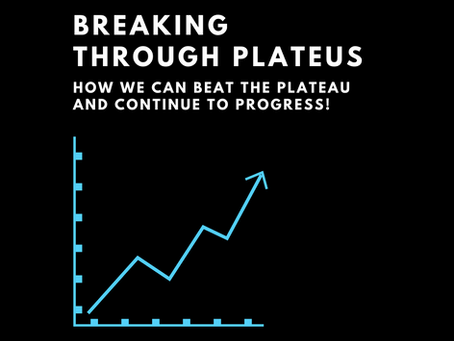Breaking Through Plateaus
Do you remember your first 2-3 months working out? Increasing the weight almost weekly, getting stronger or losing weight at a great pace, then all of a sudden, the results slow down. You try to train harder, but the results just will not come the same way that they used to. You might be stuck at bench pressing a certain weight or cannot seem to get below a certain number on the scale. This is known as a plateau.
A plateau occurs due to your body’s ADAPTATION. When you lift weights, your body sees this as a stress. Micro-tears are formed in the muscles and you get sore. Then your body will heal those tears and then “over-heal” with increased muscle and strength so that the same stress does not cause damage in the future. This is the process of building muscle and strength. However, there reaches a point where the body becomes used to the stimulus and stops adapting to it. You still cause damage and get sore and might even be training harder than you were before, but it takes a lot more work to build any sort of muscle from this point onwards.
The body does not want to build muscle. It takes a lot of energy to build, and maintain, and is inefficient with energy use (It uses a lot of calories to keep it). It evolved to become as efficient as possible, because prior to the past 100 years, food was scarce and requiring a lot of calories every day was a huge disadvantage. It does what it needs to in order to combat immediate stresses, but only to a point.
Understanding the process behind WHY we plateau is important, because it then allows us the opportunity to begin to look at how we can beat the plateau and continue to progress!
A very common approach at the gym is to find a routine, for example a push/pull/legs split, or a “Bro split” training a different body part each day for 8-12 reps, then follow it for months or years without adjustment. There are simple techniques that you can incorporate into your workout program to help you break through plateaus and continue to progress.
Before you begin to look at your training techniques however, it is a good idea to take a step back and look at your lifting form. Set up a camera and record yourself on some of the exercises you are stuck on, and this will help you to assess form breakdowns and issues with the lift that may be inhibiting your progression. Some common examples are:
Squat:
-
Not hitting depth
-
Not keeping the back tight
-
Instability throughout the lift
Bench press:
-
Excessive elbow flair
-
Lack of leg drive
-
Poor core stability
Deadlift
-
Poor movement pattern
-
Weakness in glutes
-
Lack of core stability
Some variables that you can adjust to help prevent plateaus in the future are as follows.
1. TEMPO
This variable is rarely adjusted in the everyday lifters routine and provides massive benefit. Most people lift the weight as fast as they can, and then lower it at a fast but controlled pace, with little to no pause in the movement. Utilising pause reps, and slower movements is vastly underrated and will do wonders for muscle development and strength gains and does not require the same amount of weight as if you were to lift it faster, meaning the risk of injury also goes down. Studies show that a 4-2-2 tempo is ideal for building muscle. That is 4 seconds to lower the weight, a 2 second pause, and 2 seconds to raise the weight. This is not the only option however, and there are many effective variations of tempo.
2. REP RANGE
“Everything works, but nothing works forever.”
Everybody knows that the 8-12 range is the best for building muscle. 15+ for endurance, and 1-6 for strength, right? WRONG! If you have been stuck training in the 8-12 range for any longer than 6-8 weeks you have already become adapted to it and transitioning into a different range will train your body to push a different adaptation. This different adaptation will cause you to build muscle, again, provided you do not do it forever. Then, once you transition back to your preferred rep range, you will have progressed and will be able to keep moving forward.
3. GOALS
This one is a little anti-intuitive but trust me on it. If you train for a different goal for 8 weeks, by the time you come back to your original and long term goal, you would have made progress. The different goal needs to be related and planned at an appropriate time, but for example: if you were to be training for strength and wanting to be as strong as possible in the squat, bench press and deadlift, the obvious choice may be for you to train in the 1-5 range. You may be already incorporating tempo work, and variations of those exercises, but you find yourself reaching a sticking point. It is hugely beneficial for you in this case, to take a step back. Re-evaluate your progress, look at your weak points, and then work on unilateral exercises in a 12-15 rep range, with the goal of building as much muscle as possible during this time. You would shift your focus from the movement and maximising efficiency of the exercise, to connecting better to the specific body parts that you are training and bringing up your weak points.
By the time you go back to strength training you would have addressed issues you did not realize you had, you would have taken a step back and given your central nervous system time to recover from the heavy weight, and you will begin to progress again.
The most effective way to combine these techniques, as previously stated, is through training blocks. 8 weeks is recommended, as it gives you time to mentally adjust to the new goal and get used to your new way of training to maximize your results. The types of blocks that you choose will relate to your goals, but do not be afraid to try something different. Incorporating unconventional exercises into your routine such as a yoke carry or a Turkish get up, as well as utilizing tools such as bands and chains are great ways to spice up the routine.
“Everything works, but nothing works forever”.
– Coach Alex




